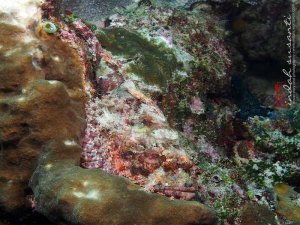Five Facts about the Scorpionfish
18th edition of Marine Life monthly post. Marine Life post published every 19th of the month. It aims to share information on specific marine life species and to promote their conservation. All images are taken by Indah Susanti unless stated otherwise.
The Scorpionfish could be spotted from the shallow waters to the deeper ocean. One of their characteristics is their capability to camouflage with their surroundings. I have heard stories snorkelers and even scuba divers were accidentally stepping or touching on scorpionfish because they were so good at hiding themselves. The result of humans contact to scorpionfish could be fatal for humans. Following is five facts to get to know this fish.
First, there are more than 200 species of the Scorpionfish in our ocean.
Second, majority species of the Scorpionfish live on the sea floor where they camouflage very well to their surroundings.
Third, they hunt at night and spend the day resting on the seafloor or corals.
Fourth, the female scorpionfish release eggs up to 15,000 into the water then fertilized by the male scorpionfish. The eggs could get eaten by predators before they hatch. The scorpionfish eggs hatch on the second day.
Fifth, they have venomous spines on their back and fins. The venoms would be injected to the ones who touch them, and their toxic are seriously dangerous. That’s one of the reasons why there are not many predators to hunt the scorpionfish. The symptoms are varied as they depend on the amount of the toxic exposure. It could get intense throbbing, nausea, fainting, or death.

Scorpionfish
How to treat Scorpionfish poisoning:
– Remove the exposed person from the water to prevent drowning.
– Immerse the wound for 30 to 90 minutes in water as hot as the poisoned person can tolerate (up to 140 F or 60 C) because the poisons are heat-sensitive. Repeat as necessary to control pain.
– Local or regional anesthetics (blocks) may be useful in some patients for pain control
– Use tweezers to remove any spines in the wound using caution not to squeeze venom glands that may have broken off in the wound with the spine. It is rare for a spine to break off in the wound. Use caution, wear gloves to avoid self-inoculation during spine removal.
– Scrub the wound with soap and water. Then flush the affected area with fresh water.
– Do not apply tape to close the wound as this may increase the risk of infection.
– Patients may need a tetanus booster; this is usually recommended for all patients with this type of poisoning. (source)
I hope by getting familiar with this species will help us in preventing “venomous” incident when enjoying the sea.
Be safe!
-comments are closed for this post-


